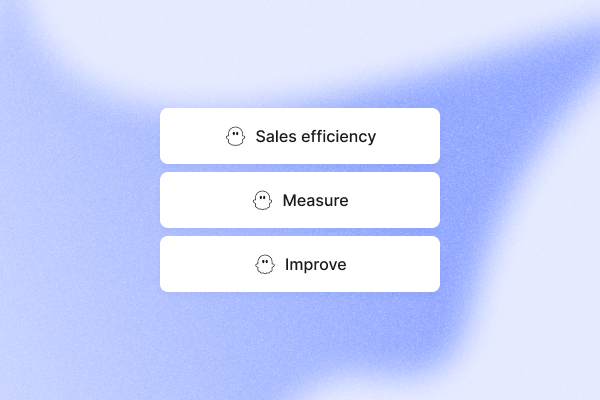Want to show how your sales team’s efforts impact the company’s bottom line? The key is to track your sales efficiency.
In this guide, we’ll break down how to measure and improve your sales efficiency, transform your lead generation approach, and close faster.
AI highlights
- Sales efficiency measures sales people’s ability to maximize revenue with minimal effort, cost, and time. It is calculated by dividing total revenue by sales and marketing costs.
- Sales efficiency is about closing more deals with fewer resources. Sales effectiveness, on the other hand, focuses on achieving higher conversion rates and long-term revenue growth.
- A 5:1 sales efficiency ratio is considered a gold standard for sustainable growth, while 1:1 signals profitability. The industry median for high-growth cloud companies is 0.7.
- In B2B SaaS sales efficiency ranges from 0.5 to 1.2, PLG models often exceed 1.0, and startups usually operate below 1.0 as they prioritize growth.
- You can improve the sales efficiency ratio using the following practices:
| Key strategy | Description | Best tool |
| Automate lead generation | Automate lead list building with LinkedIn search and sync with CRM for real-time updates | PhantomBuster’s LinkedIn Search Export to create lead lists |
| Use intent-based prospecting | Prioritize warm leads based on intent signals like engagement with competitor content, industry-related discussions, or case study downloads. | PhantomBuster’s LinkedIn Post Commenter and Liker Scraper |
| Speed up lead qualification with AI | Automatically extract up-to-date prospect data from LinkedIn profiles using intelligent automation, then feed that enriched information into your AI-led scoring system to prioritize your best-fit leads. | PhantomBuster’s LinkedIn Profile Scraper and AI LinkedIn Profile Enricher |
| Automate your LinkedIn outreach | Use automation to send tailored LinkedIn messages and timely follow-ups based on up-to-date data from your lead list. | PhantomBuster’s AI LinkedIn Message Writer |
| Optimize follow-ups | Maintain engagement by scheduling and automating 3 follow-up sequences. | PhantomBuster’s LinkedIn Outreach |
| Track key buying signals to reach prospects at the right time | Track job changes, product updates, and funding announcements to time your outreach | PhantomBuster’s HubSpot Contact Career Tracker to track job transitions of your potential prospects |
| Automate CRM updates to keep your data fresh and actionable | Automate your CRM updates by pulling fresh job titles, bios, skills, and contact details from LinkedIn to improve outreach accuracy. | PhantomBuster’s HubSpot Contact Data Enricher |
| Leverage social selling to warm up leads | Follow your prospects’ work before sending a connection request. Interact with their posts, join relevant LinkedIn groups to stay on their radar, and create natural touchpoints. | PhantomBuster’s LinkedIn Auto Follow |
| Define and continuously optimize your ICP | Refine your ICP by analyzing top customers for revenue, retention, and deal velocity insights. Layer in CRM data and sales feedback. Explore how to create an
. |
PhantomBuster’s AI Advanced Enricher |
| Refine your outreach cadence for maximum engagement | Use insights from past interactions to personalize follow-ups and optimize timing with social listening tools. | Gong |
What is sales efficiency?
Sales efficiency measures your team’s ability to generate the highest possible revenue with the least resources, effort, and time. Simply put, it’s how well your sales reps can turn prospects into actual sales.
Take a sales team that spends 20 hours weekly making $10,000 in sales. After fine-tuning their sales process further, they spent the same 20 hours, but now they’re bringing in $15,000. That’s a 50% increase in sales efficiency, which means a higher return on investment and more revenue for the business.
Sales efficiency vs. sales effectiveness
When it comes to sales, efficiency and effectiveness are both key, but they’re not the same thing. Understanding the distinction between the two can make all the difference in measuring your team’s success.
Here’s a quick comparison between the two sales aspects:
| Aspect | Sales Efficiency | Sales Effectiveness |
| Definition | Sales efficiency measures how well a sales team generates maximum revenue using the fewest resources. | Effectiveness measures your sales team’s ability to convert prospects into customers that bring lasting value to the company. |
| Focus | Optimizing speed, time, and resources. | Creating a competitive advantage and a long-term relationship with customers. |
| Metrics | Sales cycle time and deal velocity. | Conversion rate, deal size, and customer retention |
| Success indicator | Increasing revenue per resource unit (e.g., $/hour or $/effort). | Closing high-value deals that contribute to long-term business growth and customer loyalty. |
How to calculate sales efficiency
Sales efficiency is calculated by dividing the gross revenue generated by the sales team’s costs over a specific period.
Sales Efficiency Formula = Company’s revenue generated / sales and marketing costs
Say your company generated $500,000 in revenue and spent $250,000 on input sales and marketing efforts, your sales efficiency would be:
Example: 500,000 / 250,000 = 2, which means that for every $1 spent, a sales team generated $2 in revenue.
Gross sales efficiency ratio formula
The gross sales efficiency ratio focuses on how much new revenue is generated for every dollar spent on sales and marketing. Gross Sales Efficiency considers total new revenue without adjustments for churn or losses.
Here’s the formula to track it:
Gross Sales Efficiency Formula = New revenue from existing & new customers / Sales and marketing expenses.
Net sales efficiency ratio formula
The net sales efficiency ratio measures how efficiently a company generates new revenue after accounting for customer churn. By factoring in lost revenue, it provides a clearer picture of sustainable growth.
The formula to track the metrics includes:
Net sales efficiency = (New Revenue from existing and new Customers − revenue lost to churn) / sales and marketing expenses
What is a good sales efficiency ratio?
Your sales efficiency ratio shows whether your go-to-market strategy drives real growth or burns through budget. But numbers mean nothing without context.
How do you know if your efficiency is high, low, or average?
Benchmarking against industry standards provides the answer. Here’s what different ranges reveal: A sales efficiency ratio below 1 indicates that more is being spent on generating sales than what is being earned in revenue.
- Sales efficiency ratio over 5: Blake Hall, founder and CEO of ID.me, considers 5:1 the gold standard for sustainable growth. This ratio accounts for not just sales costs but also the investment needed for engineering, operations, customer acquisition costs, and other functions supporting the sales engine.
- Sales efficiency ratio around 1: This is the profitability threshold and signals that revenue is finally outpacing sales and marketing expenses.
- Sales efficiency ratio around 0.7: According to Scale Studio’s dataset of 1000+ enterprises, 0.7 is the industry median for high-growth and cloud companies. This means companies generate $0.70 in new ARR for every $1 spent on sales and marketing.
Sales efficiency benchmarks also vary based on the business model, company size, and growth stage:
| Type of organization | Sales efficiency ratio |
| B2B SaaS with enterprise sales | 0.5-1.2 |
| PLG models | 1+ |
| Startups | >1 in growth stage, 1.5+ as they grow stable |
How to improve sales efficiency for a sales team
More sales reps don’t guarantee more closed deals. A well-optimized strategy, the right tools, and precise execution do. Read on for practical ways to improve sales efficiency:
Automate lead generation to keep your pipeline full
Manually prospecting for leads is time-consuming and limits your team’s ability to scale outreach. An automation tool can remove this bottleneck and deliver fresh, targeted prospects to your pipeline without repetitive work. You can use PhantomBuster’s LinkedIn Search Export to pull fresh, targeted leads straight from LinkedIn searches.
Just expand your LinkedIn search using Boolean operators, and paste the URL into PhantomBuster.
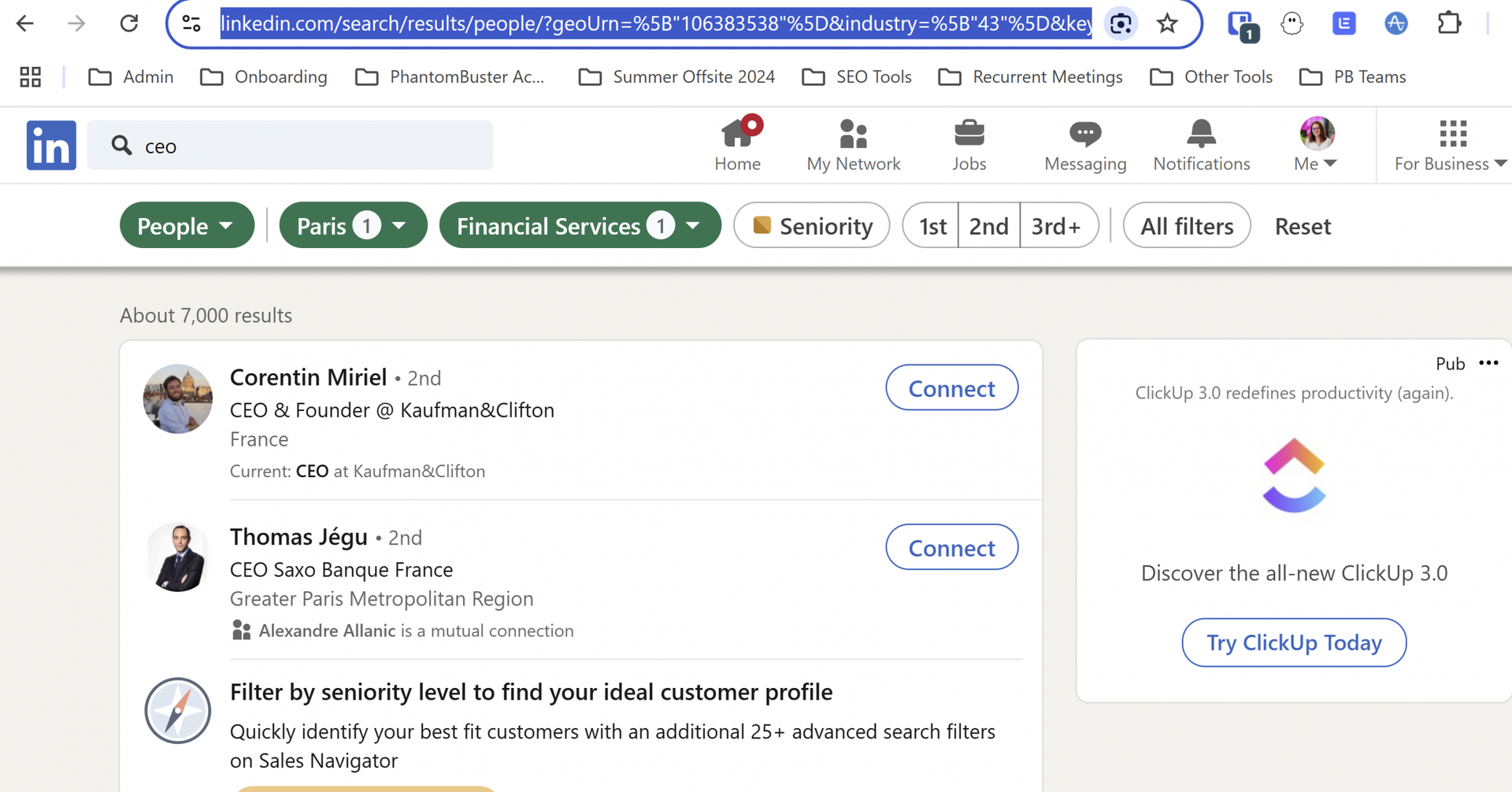
You will get a list of leads with key details like job titles, locations, certifications, and summaries.
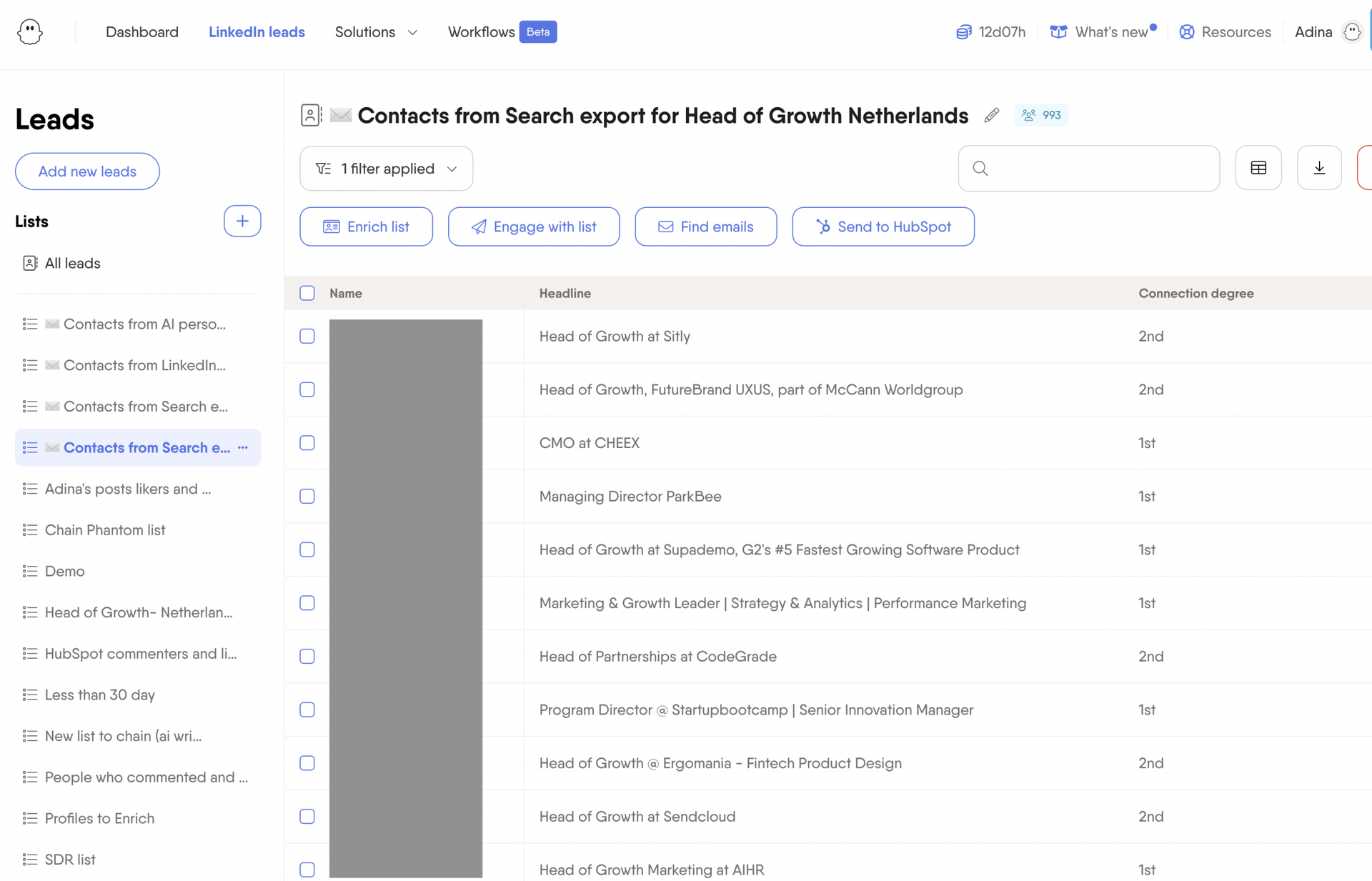
Schedule the phantom to run daily on autopilot for a steady stream of high-quality leads.
Use intent-based prospecting to find ready-to-buy leads
The best leads are the ones already showing buying intent. Your sales productivity and ROI will improve by a margin if you can prioritize warm leads who are either actively exploring solutions like yours or experiencing the pain points you solve. Explore different intent data providers to enhance this process.
One way to spot them is by looking at who’s engaging with your competitors or industry-related social content. If someone frequently interacts with posts about revenue automation, they might be a strong lead for your forecasting tool.
PhantomBuster’s LinkedIn Post Commenter and Liker Scraper lets you extract the profiles of these engaged prospects. Connect your account, enter the post URL they have, and the automation will pull a list of active users who commented and liked the post.
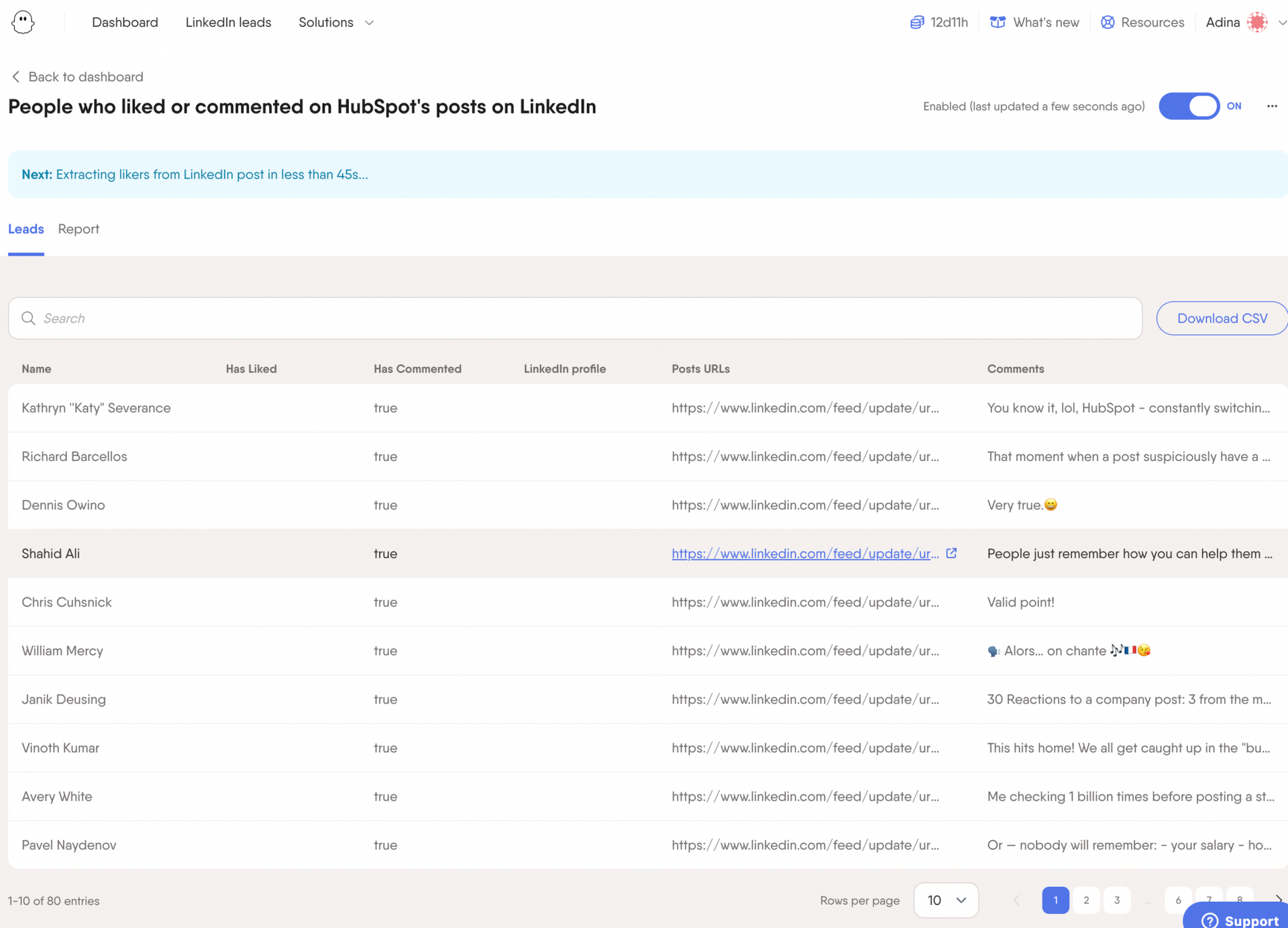
Speed up lead qualification with AI-powered enrichment
Manually scoring leads can drain your sales team’s productivity and pull your team away from actual selling. AI automates this process by analyzing engagement signals, firmographics, and buying intent to pinpoint high-potential leads.
But it can’t do much without quality prospect data.
That’s why we recommend using PhantomBuster’s LinkedIn Profile Scraper to enrich your lead list before using AI. The automation will extract fresh, real-time data from LinkedIn and sync it to your HubSpot CRM. The result? A clean, enriched list that sets you up for more accurate and efficient lead scoring.
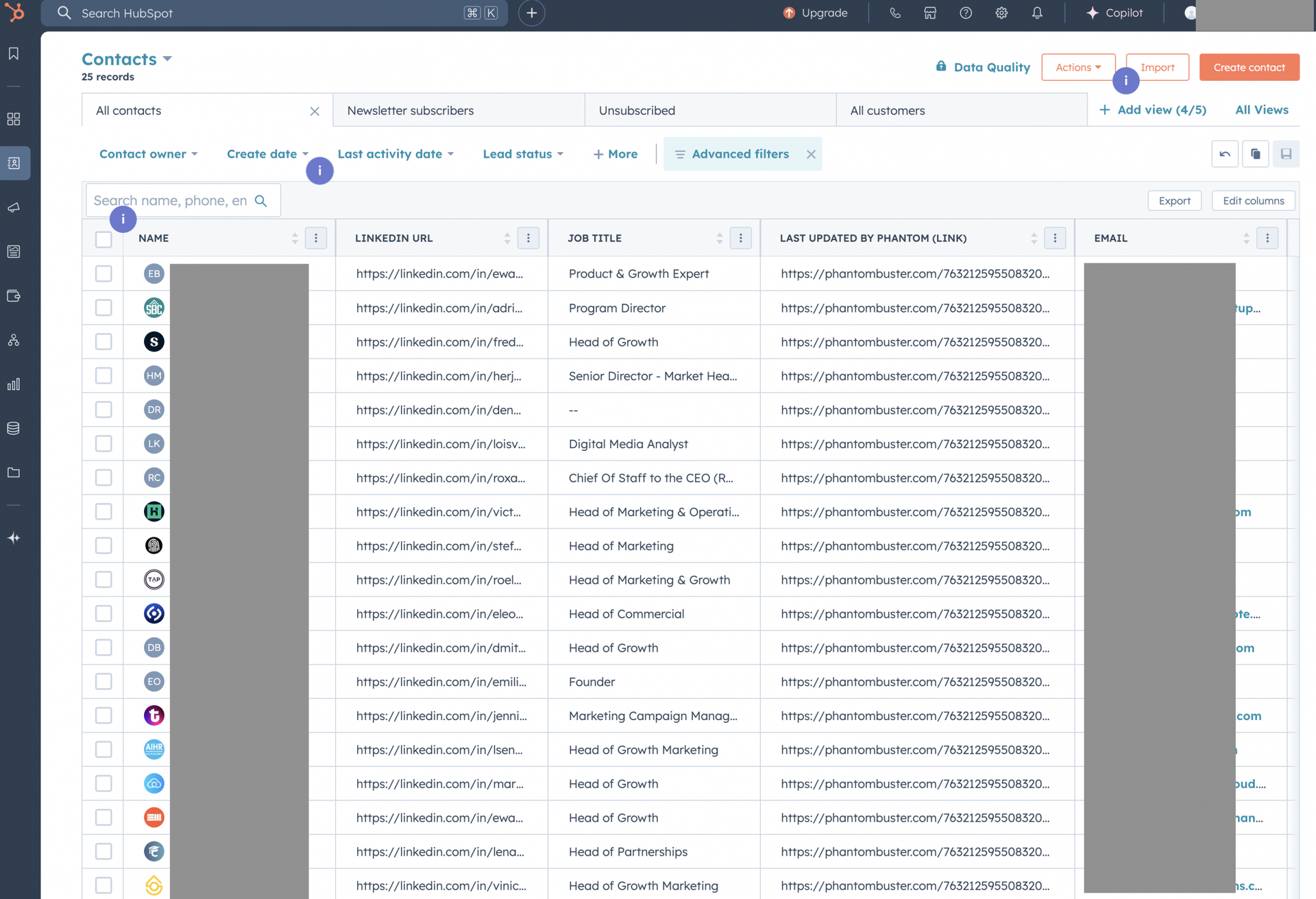
Next, use PhantomBuster’s AI LinkedIn Profile Enricher to create a custom, enterprise-wide lead-scoring framework and rank your prospects.
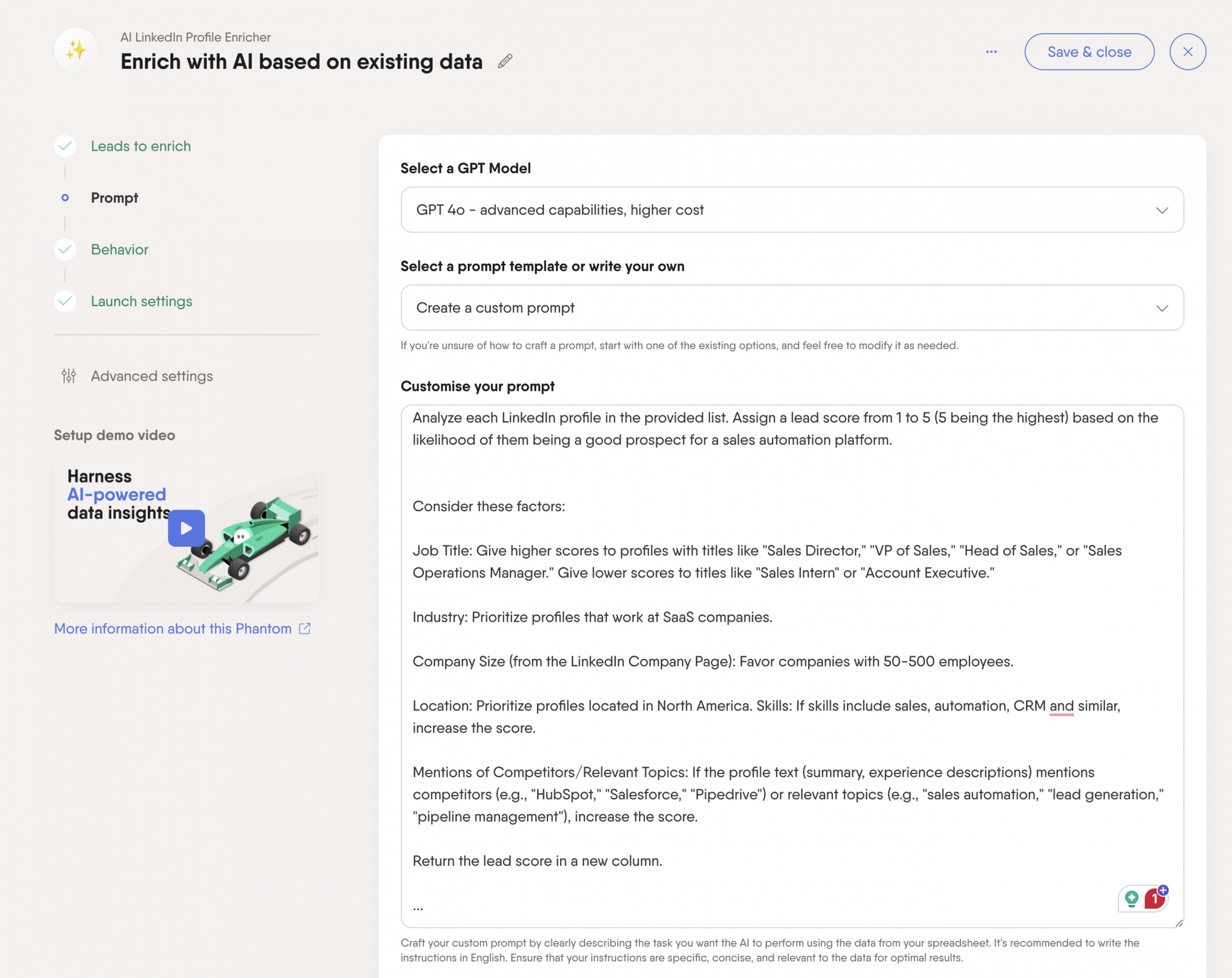
Use the lead score to segment your lead list and match prospects’ readiness to buy with the right sales tactics—whether it’s a warm follow-up or a deeper consultative pitch.
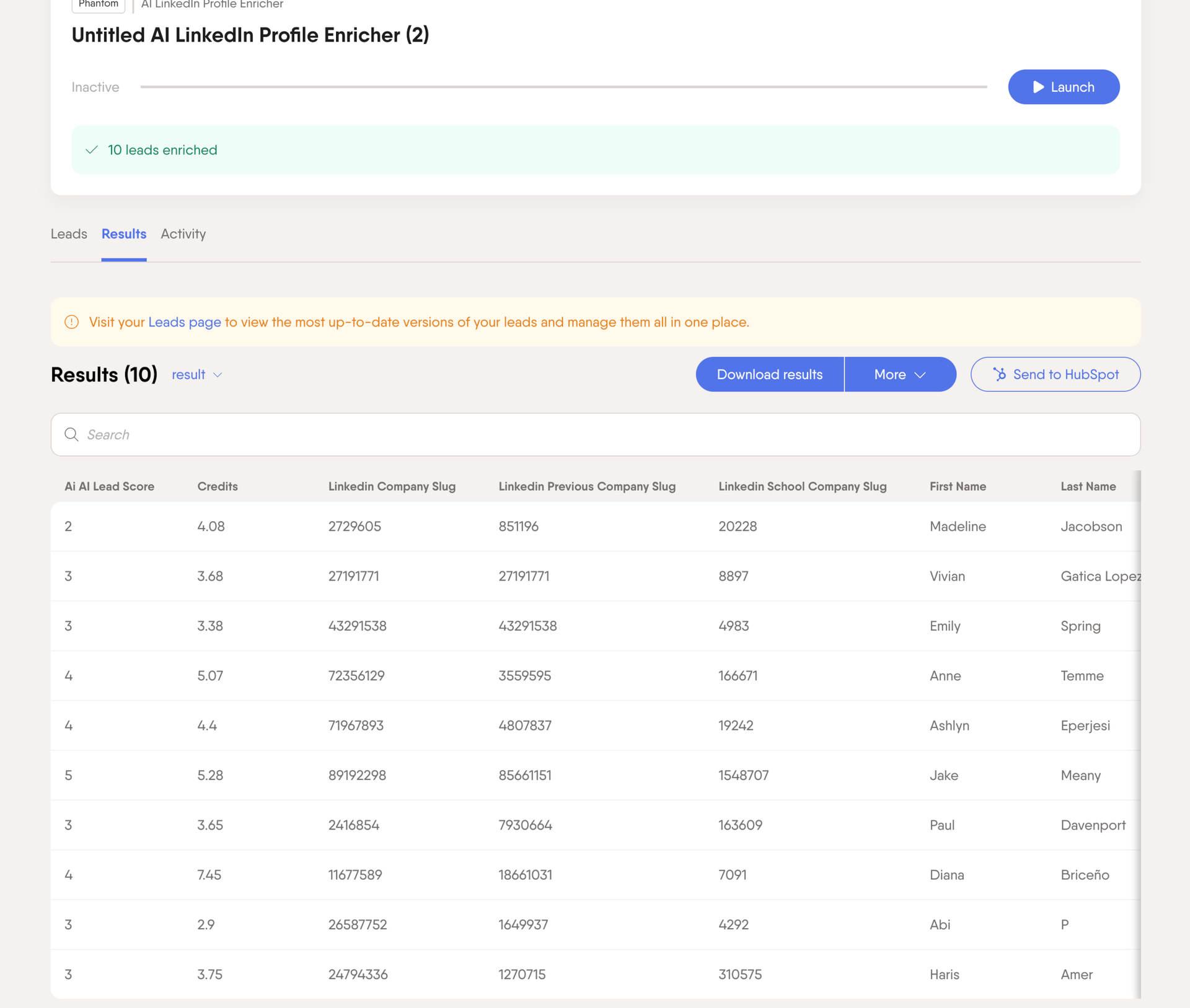
Eliminate manual outreach with automated LinkedIn messaging
Your prospect list is set, your prospect data is enriched, and your priority checklist is ready. Now, it’s time to reach out with a message that actually gets a response. PhantomBuster’s AI LinkedIn Message Writer helps you do exactly that.
The automation pulls insights from previously extracted LinkedIn data, like post comments based on your custom prompt, and turns them into a personalized pitch. Learn how to automate LinkedIn messages effectively.
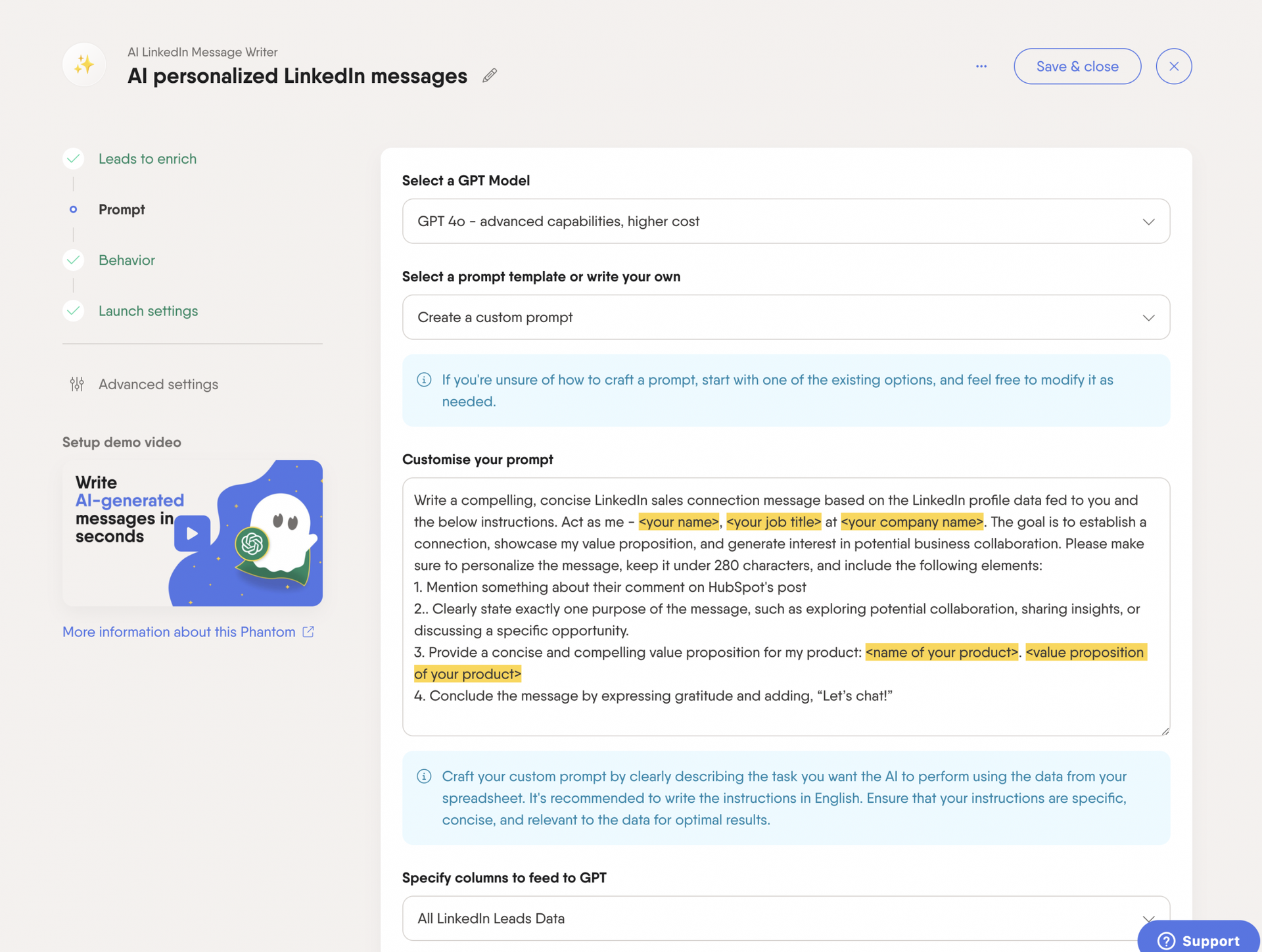
You can automate up to 3 follow-ups using LinkedIn Outreach automation to keep conversations alive without manually texting every lead. This way, you can ensure a steady flow of responses, maximize sales efficiency, and push more leads toward conversion.
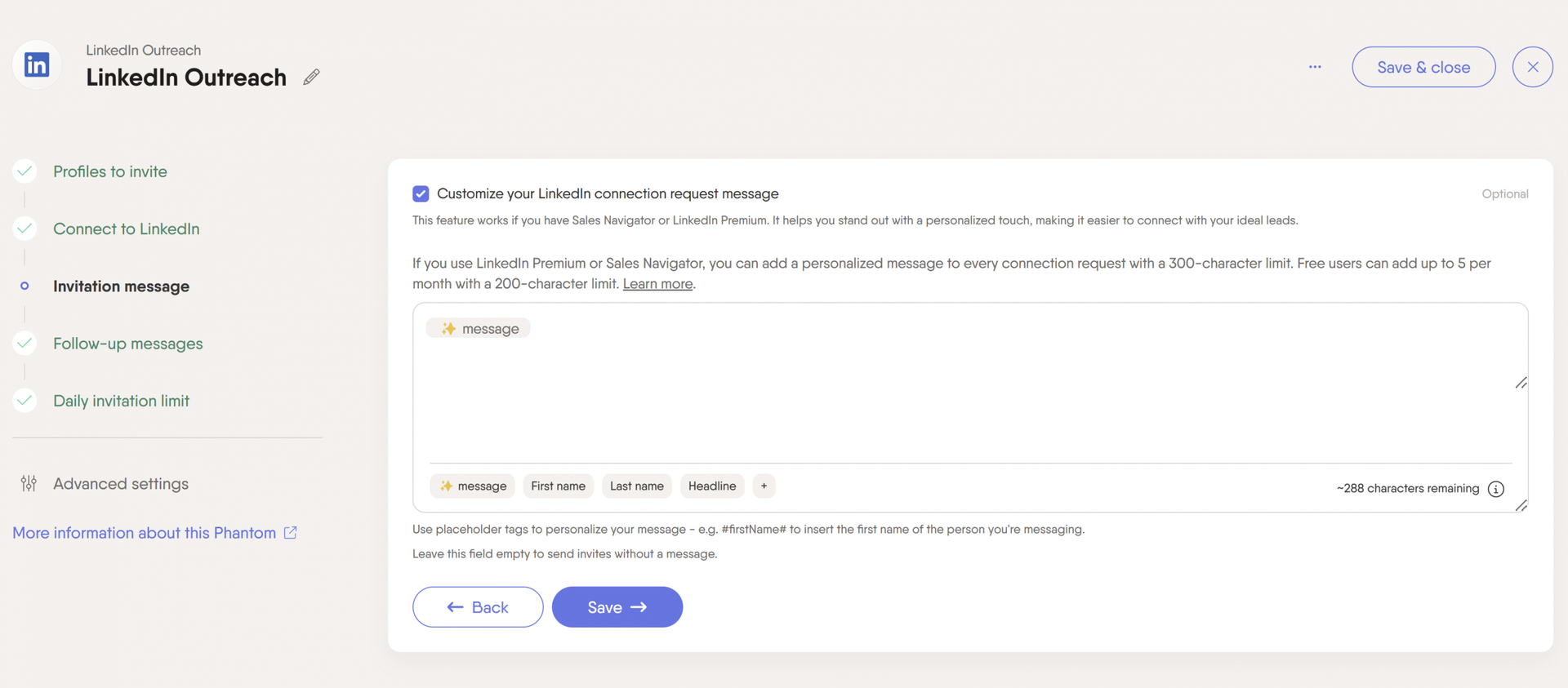
Track key buying signals to reach prospects at the right time
Timing can make or break a deal. Reaching out too early or too late often leads to missed opportunities. One of the most reliable signals that it’s the right time to engage? A recent job change. When decision-makers step into new roles, they have fresh goals and budgets to match. Discover how to identify buying signals effectively.
You can use PhantomBuster’s HubSpot Contact Career Tracker to monitor the LinkedIn profiles of your HubSpot contacts, detect job changes, and engage prospects when they’re ready to make moves.
![]()
It can also automatically update professional emails in your CRM after transitions, so you never lose contact with the prospect.

Job changes aren’t the only signal worth tracking, however. Another strong signal you should track is newly funded companies. Series A, B, or C rounds often mean aggressive growth and new vendor needs.
Set up alerts for funding announcements, track market expansions via Crunchbase and G2, and tailor your sales strategies and outreach to fit their evolving priorities.
Automate CRM updates to keep your data fresh and actionable
A clean, up-to-date CRM is essential for effective sales outreach, but outdated emails, incorrect job titles, and duplicate contacts can slow your team down. Instead of manually fixing records, automate the process. Understand the impact of dirty data on your sales efforts.
We suggest using PhantomBuster’s HubSpot Contact Data Enricher to scan LinkedIn and update your CRM with the latest info: job titles, bio, headlines, skills, and contact details. Learn about CRM data enrichment tools.
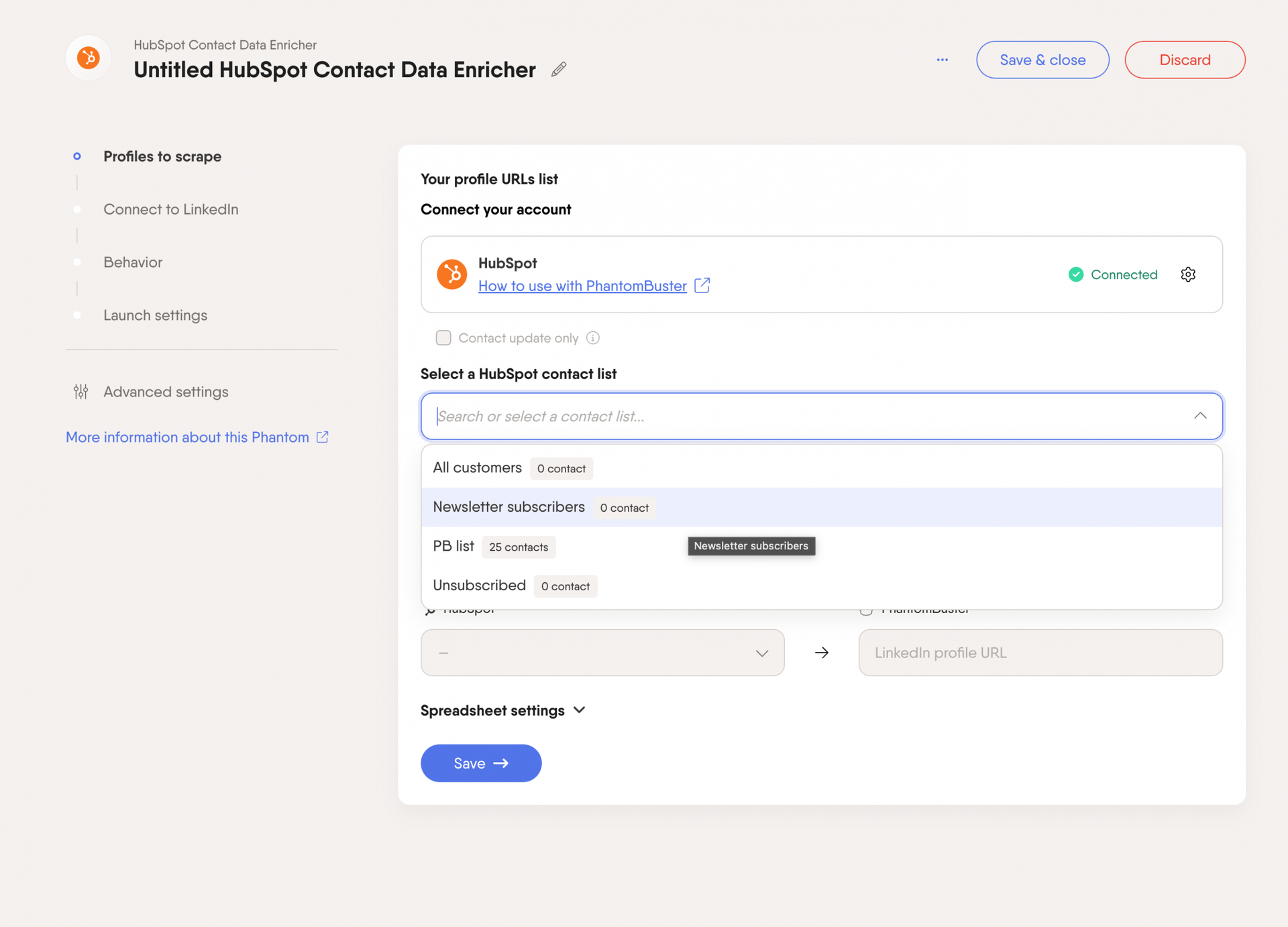
Create a continuous lead flow with 24/7 sales automation
An inconsistent lead flow slows momentum and gives competitors a head start. To stay ahead, you need round-the-clock automated prospecting that keeps your pipeline steady, no matter the time zone or business hours. Explore sales automation software tools.
With PhantomBuster’s intelligent automation, you can run your 24/7 without manual effort. Phantoms extract fresh prospect data, enrich profiles, and update your CRM in real-time so your team always has the latest insights. This way, you can have faster sales cycles, higher win rates, and a more efficient sales team without tiring yourself with the repetitive work.
Leverage social selling to warm up leads before outreach
Effective social selling means warming up leads before direct outreach. Instead of jumping straight into a pitch, engage with your prospects’ socials: add insights, ask thoughtful questions, and stay on their radar.
You can use LinkedIn Auto Follow to follow multiple prospects at scale so you see their latest updates and interact naturally.
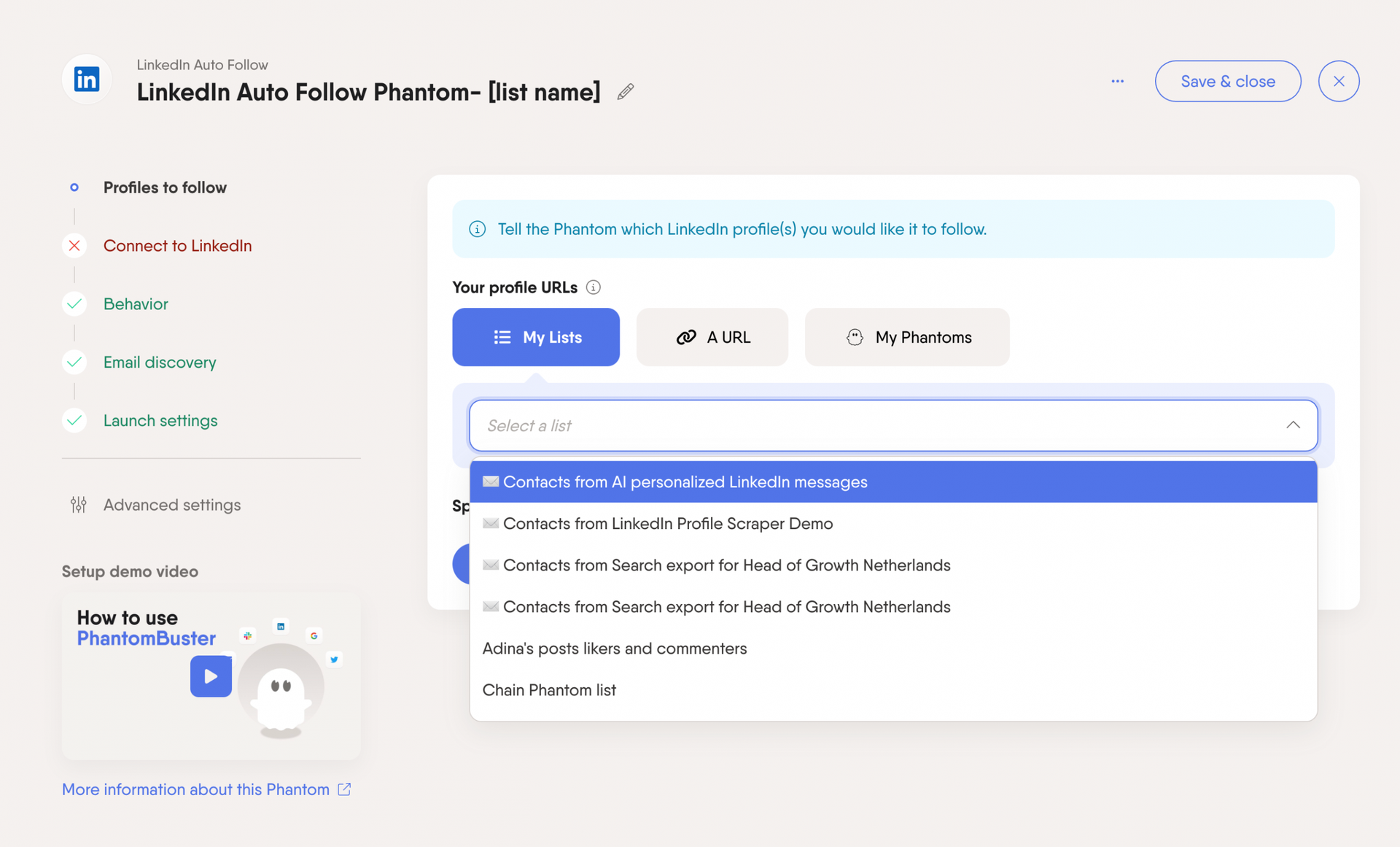
Another great way to engage is through industry-specific LinkedIn groups, where prospects already discuss their challenges. Join these spaces, add value, and create natural touchpoints. You can also run LinkedIn polls on industry trends.
Prospects who vote or comment signal interest, giving you an easy way to start a conversation.
Define and continuously optimize your Ideal Customer Profile (ICP)
Your ICP isn’t set in stone. Instead, it evolves alongside market shifts, customer behavior, and industry trends.
To refine your ICP, analyze your best customers and look for common traits in revenue, retention, and deal velocity.
While Series D enterprises may seem like prime targets, enriched data from sales, CRM, and customer interviews might reveal that mid-market companies drive faster ROI and stronger renewals.
Sales reps should have clear targets to aim for, which provide motivation and a sense of direction. Learn about ICP scoring.
Build ICP tiers based on lifetime value, contract size, and renewal potential, and adjust targeting based on real engagement data. Run A/B tests on messaging and refine your profile based on real-world feedback when in doubt.
Refine your outreach cadence for maximum engagement
A structured sales cadence makes outreach feel natural rather than robotic or salsy. Start with quick, value-packed messages and gradually deepen the conversation as interest grows. For example, if LinkedIn is your primary outreach channel, you can create an 8-day cadence starting with:
Day 1: Follow them on LinkedIn
Day 2: Like posts
Day 3: Comment on post
Day 4: Send a connection request and a follow-up thank you InMail
Day 5: Send resource (ebook, report, whitepaper)
Day 6 :Pitch personalized demo
Don’t forget to optimize your timing, frequency, and channels with a multi-dimensional outreach matrix. LinkedIn notifications and social listening tools can help track activity so you can reach out when they’re paying attention.
Sales efficiency FAQs
Sales efficiency metrics to track
Typically, a sales efficiency ratio of 3 or higher is considered exceptional. You can track the following sales metrics to get a complete picture of your sales performance:
| Metric | What it tracks | How to calculate |
| Customer acquisition cost (CAC) | The cost of acquiring a new customer | Total sales & marketing expenses / Number of new customers acquired |
| Customer lifetime value (CLV) | Projected revenue a customer will generate over their lifetime | (Average revenue per customer × Gross margin%) / Churn rate |
| LTV: CAC ratio | The return on investment for acquiring a customer (should ideally be 3:1 or higher) | Customer lifetime value / Customer acquisition cost |
| Sales cycle length | The average time taken to convert a prospect into a customer | Total time taken to close deals / Number of deals closed |
| Win rate | The percentage of opportunities converted into closed deals | (Deals won / Total opportunities) × 100 |
